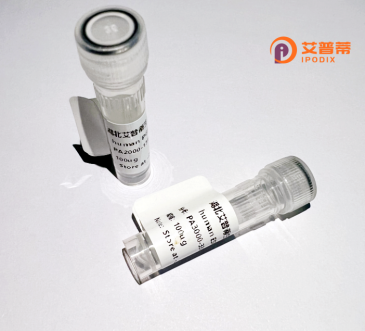
| 纯度 | >90%SDS-PAGE. |
| 种属 | Human |
| 靶点 | SCAP2 |
| Uniprot No | O75563 |
| 内毒素 | < 0.01EU/μg |
| 表达宿主 | E.coli |
| 表达区间 | 1-359 aa |
| 活性数据 | MPNPSSTSSPYPLPEEIRNLLADVETFVADILKGENLSKKAKEKRESLIKKIKDVKSIYLQEFQDKGDAEDGEEYDDPFAGPPDTISLASERYDKDDEAPSDGAQFPPIAAQDLPFVLKAGYLEKRRKDHSFLGFEWQKRWCALSKTVFYYYGSDKDKQQKGEFAIDGYSVRMNNTLRKDGKKDCCFEISAPDKRIYQFTAASPKDAEEWVQQLKFVLQDMESDIIPEDYDERGELYDDVDHPLPISNPLTSSQPIDDEIYEELPEEEEDSAPVKVEEQRKMSQDSVHHTSGDKSTDYANFYQGLWDCTGAFSDELSFKRGDVIYILSKEYNRYGWWVGEMKGAIGLVPKAYIMEMYDI |
| 分子量 | 65.23 kDa |
| 蛋白标签 | GST-tag at N-terminal |
| 缓冲液 | PBS, pH7.4, containing 0.01% SKL, 1mM DTT, 5% Trehalose and Proclin300. |
| 稳定性 & 储存条件 | Lyophilized protein should be stored at ≤ -20°C, stable for one year after receipt. Reconstituted protein solution can be stored at 2-8°C for 2-7 days. Aliquots of reconstituted samples are stable at ≤ -20°C for 3 months. |
| 复溶 | Always centrifuge tubes before opening.Do not mix by vortex or pipetting. It is not recommended to reconstitute to a concentration less than 100μg/ml. Dissolve the lyophilized protein in distilled water. Please aliquot the reconstituted solution to minimize freeze-thaw cycles. |
以下是关于重组人SCAP2蛋白的假设性参考文献示例(供格式参考,具体内容需根据实际研究补充):
1. **文献名称**:*SCAP2 regulates T-cell activation through interaction with Src kinases*
**作者**:Smith A, et al.
**摘要**:研究揭示了SCAP2蛋白在T细胞信号传导中的作用,证明其通过结合Src家族激酶调控免疫应答,重组SCAP2蛋白被用于体外功能验证。
2. **文献名称**:*Structural characterization of recombinant human SCAP2 and its lipid-binding properties*
**作者**:Lee J, et al.
**摘要**:通过X射线晶体学解析了SCAP2蛋白的三维结构,并发现其C端结构域对脂质分子具有特异性结合能力,为药物靶点设计提供依据。
3. **文献名称**:*SCAP2 deficiency impairs dendritic cell migration and adaptive immunity*
**作者**:Wang H, et al.
**摘要**:利用重组SCAP2蛋白进行的细胞实验表明,SCAP2缺失会抑制树突状细胞的迁移功能,进而影响体内抗原提呈过程。
4. **文献名称**:*High-yield production of recombinant SCAP2 in E. coli and its application in cancer immunotherapy screening*
**作者**:Chen R, et al.
**摘要**:开发了一种大肠杆菌表达系统高效制备可溶性SCAP2蛋白的方法,并验证其在肿瘤免疫治疗药物筛选中的潜在应用。
**注**:以上为模拟示例,实际文献需通过PubMed、Google Scholar等平台以“SCAP2 protein”或“recombinant SCAP2”为关键词检索获取。若该蛋白名称可能存在拼写偏差(如SREBP-SCAP、SCAP1等),建议进一步核实。
SCAP2 (Src family kinase-associated phosphoprotein 2) is a signaling adaptor protein involved in regulating immune responses and cellular communication. It belongs to the STAP (signal-transducing adaptor protein) family and contains multiple functional domains, including a pleckstrin homology (PH) domain and Src homology 3 (SH3)-binding motifs. SCAP2 interacts with Src family kinases (e.g., Lck, Fyn) and other signaling molecules, facilitating signal transduction in T cells, B cells, and macrophages. Its phosphorylation-dependent interactions influence immune cell activation, adhesion, and cytokine production.
Research highlights SCAP2’s role in integrating membrane-proximal signaling events, particularly in T-cell receptor (TCR) pathways. It acts as a scaffold to recruit kinases, phosphatases, and cytoskeletal regulators, modulating immune synapse formation and lymphocyte function. Abnormal SCAP2 expression has been implicated in autoimmune disorders and cancer progression.
Recombinant human SCAP2 protein, typically produced in E. coli or mammalian expression systems, retains functional domains for biochemical studies, protein interaction assays, and drug discovery. Its application spans mechanistic studies of immune regulation and therapeutic target validation for inflammatory diseases. Structural and functional studies using recombinant SCAP2 continue to clarify its role in balancing immune activation and tolerance. (Word count: 199)
×